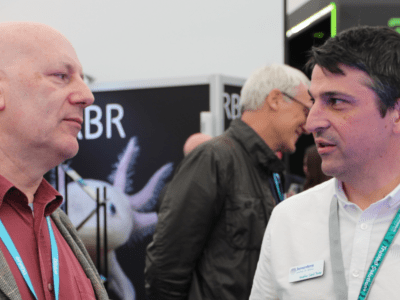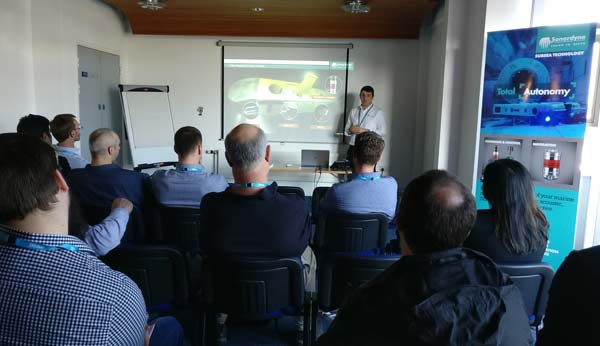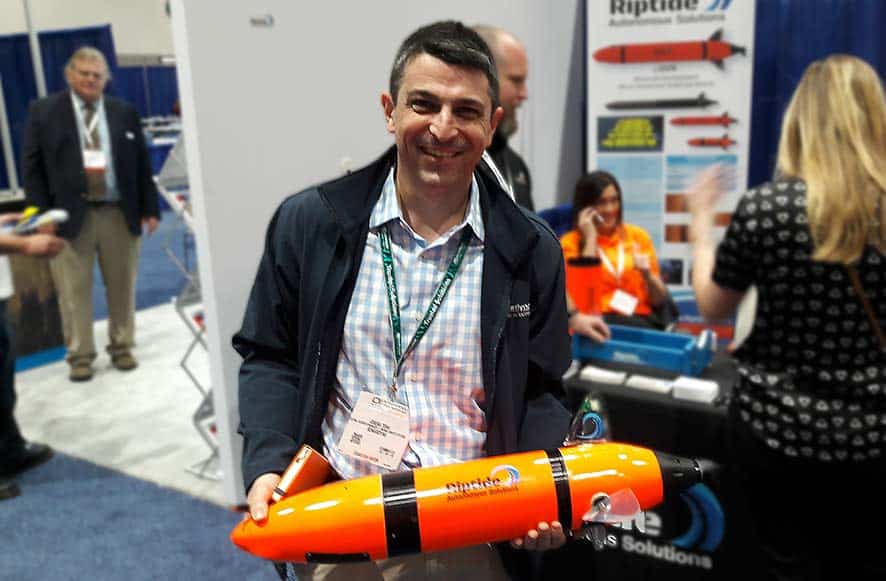Blog written by: Ioseba Tena, Global Business Manager – Marine Robotic Systems, Sonardyne International Ltd.
 Walking around Ocean Business 2017 in Southampton a couple of weeks ago was fun. All the usual Autonomous Underwater Vehicle (AUVs) providers were in attendance boasting, rightfully, about the growth in the sector. I was also glad to see, alongside the established companies, new players emerging. The shapes, sizes, applications and concepts for operating the systems on offer are mind-blowing. I enjoyed the discussions too. One moment I was having a conversation about a life resident AUVs stationed offshore at thousands of metres depth servicing an offshore field, the next I was talking about swarms of small AUVs collaborating to carry out detailed oceanographic surveys.
Walking around Ocean Business 2017 in Southampton a couple of weeks ago was fun. All the usual Autonomous Underwater Vehicle (AUVs) providers were in attendance boasting, rightfully, about the growth in the sector. I was also glad to see, alongside the established companies, new players emerging. The shapes, sizes, applications and concepts for operating the systems on offer are mind-blowing. I enjoyed the discussions too. One moment I was having a conversation about a life resident AUVs stationed offshore at thousands of metres depth servicing an offshore field, the next I was talking about swarms of small AUVs collaborating to carry out detailed oceanographic surveys.
Just where are my AUVs?
Each and every time the subject came back to one recurring theme; “Just where are my AUVs?” AUVs spend all their working hours out of sight, silently ‘mowing the lawn’ and working hard to gather your ocean data. But whatever role you assign them, from monitoring a pipeline, searching for debris or looking for mines, one thing’s in common – you always want to know where your very expensive assets are.
![]() All surveys starts with very careful planning. While the AUVs sit on the deck, the operator plans the mission in meticulous detail; checking each and every waypoint to make sure that the AUVs will be successful, and in particular, will not collide with obstacles along their route. When the mission is ready, it is uploaded into the AUVs’ control systems and then… it’s leap of faith time. The AUVs are released into the sea. They submerge and that’s it. They are gone for hours. Managing one AUV is hard enough, but judging from my conversations at Ocean Business emerging concepts of operations require that we track and monitor multiple systems.
All surveys starts with very careful planning. While the AUVs sit on the deck, the operator plans the mission in meticulous detail; checking each and every waypoint to make sure that the AUVs will be successful, and in particular, will not collide with obstacles along their route. When the mission is ready, it is uploaded into the AUVs’ control systems and then… it’s leap of faith time. The AUVs are released into the sea. They submerge and that’s it. They are gone for hours. Managing one AUV is hard enough, but judging from my conversations at Ocean Business emerging concepts of operations require that we track and monitor multiple systems.
This is where our AvTrak instrument comes in. I’ve only been with Sonardyne a few months but I’ve quickly come to appreciate that it’s one of the most versatile of instrument platforms you could fit to your AUV. Inertial aiding, long-range tracking, communicating and mission planning – you got it. And with the introduction of the Nano OEM version which is about the size of your business card, no matter how small your vehicle is – you can get in on-board.
All models of AvTrak are 6G compatible so not only can they measure ranges to reference transponders with great precision, they can also exchange data within each range update cycle. Through the use of simple open interfaces and protocols, using Wideband 2 ranging and data exchange capabilities, AvTrak can act as beacon for a surface USBL. It can also communicate with surface vessels, transponders on the seabed and other AUVs. Share health status updates, alter mission plans, share goals, harvest data … The possibilities are endless.
Tom Bennetts Projects Manager at Sonardyne demonstrated AvTrak functionality during Ocean Business, “Customers were impressed by the ability to tag along data with every ranging cycle, and how the system could automatically adapt the pings to fit more data if required. We are talking about a system built using a technology platform proven world-wide from thousands of deployments.”
One size doesn’t fit all
I personally think that the beauty of our AvTrak 6 family of instruments lies in the flexibility it affords the AUV manufacturers and their users. Yes… we can track tens of AUVs. We work out their position. We can communicate it back to them using advanced, acoustic bi-directional communications. The truth is we could do that since the introduction of Wideband!
personally think that the beauty of our AvTrak 6 family of instruments lies in the flexibility it affords the AUV manufacturers and their users. Yes… we can track tens of AUVs. We work out their position. We can communicate it back to them using advanced, acoustic bi-directional communications. The truth is we could do that since the introduction of Wideband!
We’ve worked hard to make the instruments compatible with every AUV platform and judging from the technology displayed at Ocean Business, I’m glad we did this. Today our 7,000 metre depth rated AvTrak 6 is capable of meeting the most strict accuracy requirements at extreme ranges. It offers an emergency battery lasting 30 days, control of releases, burn-wire and a drop weight function. In contrast our AvTrak 6 Nano OEM measuring just 88 mm x 56 mm offers the same tracking and data exchange and still boasts 10 days of emergency relocation battery life – just in case the worst happens! It has already been integrated to micro-AUVs making them compatible with a world-wide network of survey vessels equipped with our 6G USBL systems.
Remember whether you are running four or twenty four hour missions, all missions cost; mobilisation, crew, support vessel, ancillary equipment, time and demobilisation. Tracking the AUV can help mitigate for errors in the planning and in the execution. You can check as the mission evolves that your AUV is where you need it to be. Your AUV can save you money by not getting lost and it can make you money by going where it needs to go!
So next time you are wondering where your AUVs are, get in touch with us. We will help you find them.
